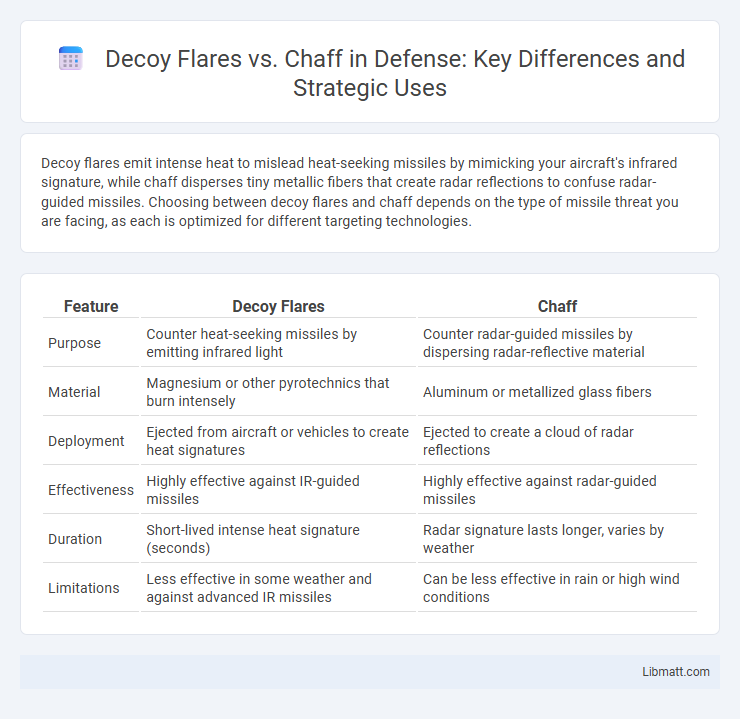Decoy flares emit intense heat to mislead heat-seeking missiles by mimicking your aircraft's infrared signature, while chaff disperses tiny metallic fibers that create radar reflections to confuse radar-guided missiles. Choosing between decoy flares and chaff depends on the type of missile threat you are facing, as each is optimized for different targeting technologies.
Table of Comparison
| Feature | Decoy Flares | Chaff |
|---|---|---|
| Purpose | Counter heat-seeking missiles by emitting infrared light | Counter radar-guided missiles by dispersing radar-reflective material |
| Material | Magnesium or other pyrotechnics that burn intensely | Aluminum or metallized glass fibers |
| Deployment | Ejected from aircraft or vehicles to create heat signatures | Ejected to create a cloud of radar reflections |
| Effectiveness | Highly effective against IR-guided missiles | Highly effective against radar-guided missiles |
| Duration | Short-lived intense heat signature (seconds) | Radar signature lasts longer, varies by weather |
| Limitations | Less effective in some weather and against advanced IR missiles | Can be less effective in rain or high wind conditions |
Introduction to Decoy Flares and Chaff
Decoy flares and chaff are essential countermeasures used by military aircraft to evade radar-guided and infrared-guided missiles. Decoy flares emit intense infrared radiation to mislead heat-seeking missiles, while chaff disperses fine metal fibers to create radar-reflective clouds that confuse radar systems. Both technologies enhance aircraft survivability by disrupting missile targeting systems during combat scenarios.
How Decoy Flares Work
Decoy flares function by emitting intense infrared radiation that mimics the heat signature of an aircraft's engines, thereby diverting heat-seeking missiles away from the actual target. These flares create a thermal distraction by burning at extremely high temperatures, confusing missile guidance systems reliant on infrared tracking. Compared to chaff, which disperses radar-reflective material to confuse radar-guided missiles, flares specifically target infrared homing threats through heat emission.
Chaff: Mechanism and Deployment
Chaff consists of small, thin strips of metal or metallized glass fiber released by aircraft to create a cloud of radar-reflective material, confusing radar-guided missile systems. Upon deployment, the chaff disperses rapidly in the air, generating numerous false radar targets that obscure the actual aircraft's position. This mechanism effectively deceives radar seekers by overwhelming their tracking capabilities with multiple echo signals.
Key Differences Between Flares and Chaff
Decoy flares and chaff serve as countermeasure systems against missile threats, but they operate differently: flares emit intense infrared radiation to mislead heat-seeking missiles, while chaff disperses tiny aluminum or metallized glass fibers to create radar-reflective clouds that confuse radar-guided missiles. Flares are primarily effective against infrared-guided missiles by mimicking the heat signature of an aircraft's engines, whereas chaff targets radar systems by generating false targets on enemy radar screens. The choice between deploying flares or chaff depends on the missile type and guidance system, making both essential for comprehensive missile defense.
Types of Threats Countered
Decoy flares primarily counter infrared-guided missiles by emitting intense heat signatures that mislead heat-seeking sensors away from your aircraft. Chaff targets radar-guided missiles by dispersing clouds of tiny metallic fibers that create multiple false targets on enemy radar systems. Understanding the specific threat type is crucial for selecting the appropriate countermeasure to enhance your defense capabilities.
Effectiveness in Combat Scenarios
Decoy flares are highly effective against infrared-guided missiles by emitting intense heat signatures that divert the missile away from the aircraft. Chaff consists of small, thin aluminum strips that create a radar-reflective cloud, confusing radar-guided missiles and enhancing survivability in electronic warfare environments. Combining both countermeasures increases the likelihood of evading multi-mode missile threats in complex combat scenarios.
Limitations of Decoy Flares and Chaff
Decoy flares have limited effectiveness against modern infrared-guided missiles due to their fixed burn time and predictable heat signature, which advanced seekers can distinguish from actual aircraft. Chaff effectiveness is constrained by its reliance on radar frequency and density; sophisticated radar systems equipped with frequency hopping can filter out chaff clutter. Both countermeasures face challenges as missile and radar technologies advance, diminishing their ability to reliably deceive threats.
Technological Advancements
Decoy flares have evolved with advanced pyrotechnic compositions and infrared signature enhancement, effectively misleading heat-seeking missiles by mimicking your aircraft's thermal footprint. Chaff technology has progressed with precision-dispensing systems that create radar-reflective cloud patterns, confusing enemy radar-guided weapon systems more efficiently. These technological advancements in both countermeasure systems provide comprehensive defense layers, enhancing survivability in modern threat environments.
Integration in Modern Defense Systems
Decoy flares and chaff are critical components integrated into modern defense systems to counteract missile threats effectively. Flare systems emit intense infrared signals to mislead heat-seeking missiles, while chaff disperses metallic fibers that create radar-reflective clouds, confusing radar-guided missiles. Advanced combat aircraft and naval vessels incorporate these countermeasures within automated electronic warfare suites for real-time threat detection and deployment, enhancing survivability against diverse missile attacks.
Future Trends in Aircraft Countermeasures
Decoy flares and chaff remain critical components of aircraft countermeasures, with future trends emphasizing enhanced spectral separation and adaptive release mechanisms to outsmart increasingly sophisticated missile seekers. Advances in material science are driving the development of flares with extended burn times and chaff clouds optimized for radar scatter across multiple frequencies. Your aircraft's survivability will significantly benefit from integrating AI-driven deployment systems that analyze threat environments in real-time to optimize countermeasure effectiveness.
decoy flares vs chaff Infographic

 libmatt.com
libmatt.com